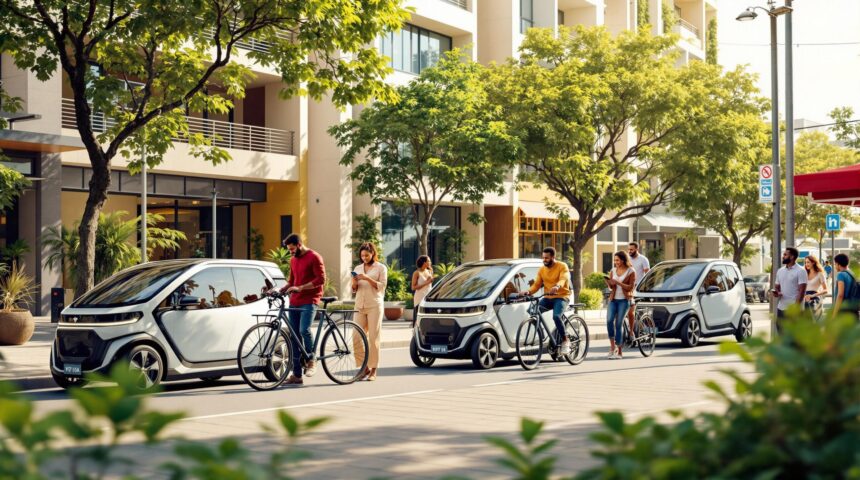The MobilityTech sector in Africa is rapidly growing, driven by urbanization, sustainability, and innovative financing. Different regions across the continent are leading the charge in transforming transportation with sustainable and accessible solutions. Let’s take a closer look at the top regions making waves in the MobilityTech space.
- Northern Africa: Northern Africa, particularly Egypt, is a hub for MobilityTech investment. In 2023, the region attracted $640 million in investments, with a focus on electric mobility and digital transformation. Companies like Shift EV, specializing in fleet electrification for emerging markets, secured significant funding. Advancements in electric vehicle projects, digital marketplace development, and collaborations with international investors are driving momentum in the region. Despite challenges like infrastructure gaps, startups are addressing these hurdles through innovative financing models and partnerships.
- West Africa: West Africa, led by Nigeria, attracted $400 million in mobility tech funding in 2023. Key players like MAX and Moove are reshaping the transportation landscape with innovative solutions like flexible vehicle financing and subscription-based services. Companies like T40 Technologies are improving intercity travel and logistics through digital platforms. The region continues to grow, with startups raising $178.6 million in Q1 2024.
- Central Africa: Central Africa is emerging as an opportunity-filled region in the MobilityTech space. Startups like BEE in Cameroon and Rwanda secured significant funding in 2023, focusing on logistics, e-mobility, and drone technology. Despite infrastructure challenges and regulatory barriers, local investors are tapping into the potential of Francophone markets, developing solutions tailored to the region’s needs.
- Southern Africa: Southern Africa is a key player in MobilityTech, attracting $600 million in funding in 2023. Emphasizing e-mobility and digital logistics, the region holds its ground as the third-largest VC market in Africa. Companies like AUTO24.africa are boosting vehicle accessibility and trade through online marketplaces, contributing to the region’s mobility ecosystem.
Each region has its unique challenges and opportunities in the MobilityTech sector. While Northern Africa leads in electric mobility and digital platforms, West Africa drives growth through inventive solutions and creative financing models. Central Africa and Southern Africa are also making strides in addressing transportation challenges and building sustainable mobility solutions. With collaborations and investments flowing into the sector, Africa’s MobilityTech landscape is poised for further growth and innovation. Southern Africa is distinguishing itself in the realm of sustainable transportation and digital logistics. This region is focusing on key areas such as e-mobility, digital logistics, and urban mobility to drive innovation and progress in the mobility sector.
In the realm of e-mobility, Southern Africa is advancing clean technology and building infrastructure to support electric vehicles (EVs). This push towards sustainable transportation is expected to increase adoption rates and reduce the region’s carbon footprint. Additionally, the development of digital logistics platforms in Southern Africa is aimed at improving supply chain efficiency and enhancing operational processes.
One notable example of Southern Africa’s commitment to mobility innovation is AUTO24.africa’s expansion in the region. This move highlights the readiness of Southern Africa to embrace scalable digital automotive solutions tailored to local needs. Despite a slowdown in funding levels in 2023, local investors are stepping in to support growth and tap into untapped market opportunities.
Startups in Southern Africa are addressing challenges by implementing flexible financing models, forming partnerships with local organizations, and creating customized solutions to meet specific demands. These efforts are aimed at driving accessibility and improving transportation solutions in the region.
With a growing urban infrastructure and increasing demand for transport innovation, Southern Africa is positioned as a key testing ground for mobility technologies. These advancements not only benefit the region but also set the stage for scalable solutions that can be implemented across other African markets.
While Southern Africa leads in sustainable transportation and digital logistics, East Africa is emerging as a promising market for mobility tech. Countries like Kenya are spearheading initiatives in electric mobility and sustainable transit solutions. By focusing on practical and eco-conscious approaches to transportation, East Africa is carving out unique opportunities for growth and progress in the mobility sector.
Overall, Africa’s mobility tech sector is undergoing rapid changes, with a focus on sustainability and financial inclusion. Despite fluctuations in funding levels, the sector continues to show resilience and potential for further growth. By harnessing innovation, collaboration, and a commitment to sustainability, African regions like Southern Africa and East Africa are shaping the future of mobility across the continent. Transportation is on the brink of a major transformation as new trends emerge in the sector. These advancements are not only addressing local challenges but also tapping into global opportunities, shaping the future of how we move from one place to another.
One of the key trends driving this transformation is the rise of electric vehicles (EVs). With concerns about climate change and air pollution on the rise, more and more people are turning to EVs as a cleaner and more sustainable mode of transportation. As technology continues to improve, EVs are becoming more affordable and accessible, making them a viable option for a larger segment of the population.
Another trend that is reshaping transportation is the development of autonomous vehicles. These self-driving cars have the potential to revolutionize the way we travel, making roads safer and more efficient. With companies like Tesla, Waymo, and Uber investing heavily in autonomous technology, it’s only a matter of time before we see these vehicles on the streets in large numbers.
In addition to EVs and autonomous vehicles, other trends such as ride-sharing, bike-sharing, and public transportation advancements are also playing a significant role in transforming the transportation sector. These innovations are not only making it easier for people to get around, but they are also reducing traffic congestion and carbon emissions.
As these trends continue to advance, the transportation sector is poised to undergo a dramatic shift. Local challenges such as traffic congestion, air pollution, and inadequate infrastructure are being addressed, while global opportunities for growth and innovation are being explored. From smart cities to hyperloop technology, the future of transportation is exciting and full of possibilities.
In conclusion, the transportation sector is on the cusp of a major transformation. With advancements in electric vehicles, autonomous technology, ride-sharing, and more, the way we move from place to place is evolving rapidly. By embracing these trends and investing in sustainable and efficient transportation solutions, we can create a more connected, accessible, and environmentally friendly world for future generations. With the rise of social media and digital technology, the way we consume news and information has drastically changed in recent years. Traditional forms of media, such as newspapers and television news, are no longer the primary sources of information for many people. Instead, social media platforms like Facebook and Twitter have become the go-to sources for breaking news and updates on current events.
One of the key reasons for this shift is the speed at which information can be disseminated through social media. With just a few clicks, users can share news articles, videos, and other content with their followers, allowing information to spread rapidly across the internet. This has led to a phenomenon known as "citizen journalism," where ordinary people can report on events as they happen and share their perspectives with a global audience.
Another factor driving the popularity of social media as a news source is the ability to personalize content. Users can curate their feeds to follow specific news outlets, journalists, and topics of interest, ensuring that they receive updates on the stories that matter most to them. This level of customization is not possible with traditional media, which often presents a one-size-fits-all approach to news coverage.
However, the rise of social media as a news source is not without its challenges. The spread of misinformation and fake news has become a major concern, as unverified or inaccurate information can quickly go viral and mislead the public. Social media platforms have taken steps to combat this issue, such as implementing fact-checking tools and algorithms to flag false information. However, the sheer volume of content being shared on these platforms makes it difficult to catch every instance of misinformation.
Additionally, the echo chamber effect of social media can create filter bubbles, where users are only exposed to information that aligns with their existing beliefs and opinions. This can lead to polarization and the spread of biased or one-sided perspectives, making it harder for users to see the full picture of a given issue.
Despite these challenges, social media remains a powerful tool for news consumption in the digital age. Its ability to deliver real-time updates, personalized content, and a platform for citizen journalism make it a valuable resource for staying informed. As social media continues to evolve, it will be important for users to critically evaluate the information they encounter and seek out diverse perspectives to ensure they are getting a well-rounded view of the world around them.







